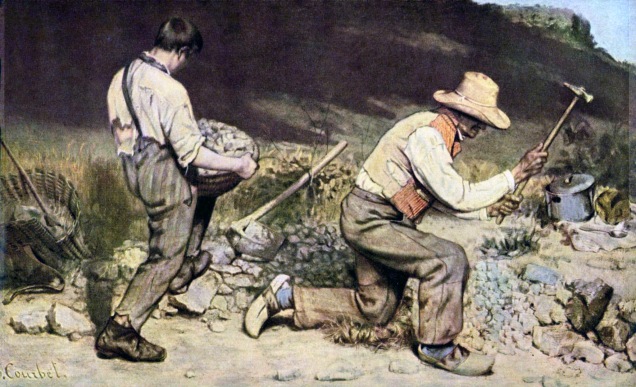
Unlike fellow Realist Jean-François Millet, who was known for depicting more idealised, hale and hearty rural workers, Gustave Courbet depicted road menders wearing ripped and tattered clothing in his painting, The Stone Breakers.
This is not meant to be a heroic painting: it is meant to be an accurate account of the deprivation that was a common feature of mid 19th century French rural life.
Courbet wanted to show what was really occurring at the time, unlike the popular paintings which generally idealised the middle and upper classes. In this monumental painting (it was 1.65 m x 2.57 m) he painted a scene he had witnessed of two men breaking stones beside the road. He told his friends the art critic Francis Wey and Champfleury: “It is not often that one encounters so complete an expression of poverty and so, right then and there I got the idea for a painting. I told them to come to my studio the next morning.”*
The two faceless stone breakers in Courbet’s painting are set against a low hill common in the rural French town of Ornan, where the artist had been raised and continued to spend much of his time.

Courbet has used the difference in stone breakers’ ages to symbolise the cycle of poverty, and he has ‘cast light’ on their plight by placing them in strong light across the foreground of the painting, with the shadow of the hills behind them and only a small patch of blue in the upper right.
But see how our eye is then drawn from the patch of sky down through the long hammer back towards the endeavours of the older stone breaker, and then across his backward facing leg to the younger man. We are back to the central subjects of the work – they dominate the work no matter where we look.
However, Courbet has carefully added details to the painting so we know a little more about their lives – for example, their clothes are clearly tattered and ill fitting. We can see a cooking pot, a loaf of bread and a spoon on the left, sitting on an old cloth – so that we know there is little respite from their day’s work. On the right we see a basket to carry debris, with a scythe lying on the rocks between the workers, so we can assume that as well as breaking the stones, the labourers are clearing the land.
With his forearm exposed and his muscles appearing taut, we get a sense that that basket of rocks being held by the younger man is very, very heavy. We can also assume from the light and the hat being pulled low over the older man’s face that they are working in the heat.
There is nothing idyllic about this scene.
Like Millet, Courbet has used a very limited palette – it is only the small amount of the blue/grey and orange which bring relief from the muted earthy colours.
_____________________
Works such as these by Courbet prompted accusation of political associations, but the artist’s actual relationship with politics was complex. He called himself a “republican by birth” but didn’t take up arms during the 1848 Revolution (just prior to painting of the Stone Breakers), adhering to his pacifist beliefs. However, on the eve of the Paris Commune of 1871 he played an active role in the political and artistic life of this short-lived socialist government. With the demise of the Commune, Courbet was arrested and sentenced to six months imprisonment for his involvement in the destruction of the Vendôme Column, a symbol of Napoleonic authority.
He was a complex man labelling himself the “proudest and most arrogant man in France“. On one hand living a highly fashionable life, and on the other being a leader of the Realist movement through his commitment to painting everyday subjects drawn from modern life. (You get a sense of his arrogance from an early self portrait and another of his paintings, Good Day Monsieur Courbet, 1854- Courbet is on the right)


Unfortunately The Stonebreakers was a casualty of war: it was destroyed during World War II, along with 154 other pictures, when a transport vehicle moving the pictures to the castle of Königstein near Dresden was bombed by Allied forces in February 1945.
* as quoted on Wikipedia; Masanès, Fabrice 2006, p. 31
This short story is a short except from my e-course Introduction to Modern European Art in which you will discover the history of art from Romanticism through to Abstract Art.